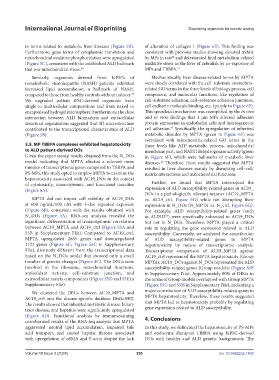Page 264 - IJB-10-3
P. 264
International Journal of Bioprinting Bioprinting organoids for toxicity testing
in terms related to metabolic liver diseases (Figure 5B). of alteration of collagen I (Figure 6E). This finding was
Furthermore, gene terms of cytoplasmic translation and consistent with previous studies showing elevated αSMA
mitochondrial oxidative phosphorylation were upregulated by MPs in rats and deteriorated lipid metabolism-related
44
(Figure 5C), consistent with the established ALD hallmark oxidative stress in the liver of zebrafish by co-exposure of
that was mitochondrial stress. 40 MPs and TBBPA. 12
Similarly, organoids derived from hiPSCs of Mechanistically, liver disease-related terms by MPTA
nonalcoholic steatohepatitis (NASH) patients exhibited were closely correlated with the cell–substrate interaction-
increased lipid accumulation, a hallmark of NASH, related GO terms in the three levels of biology process, cell
compared to those from healthy controls without inducer. component, and molecular functions, like regulation of
39
We upgraded patient iPSC-derived organoids from cell–substrate adhesion, cell–substrate adhesion junctions,
single to multicellular compositions and from naked to cell cadherin molecule binding, etc. (purple in Figure 6F).
encapsulated hydrogel microsphere. Furthermore, the close This speculated mechanism was exemplified by the in vivo
interaction between ALD biomarkers and extracellular and in vitro findings that 1 μm MPs affected adhesion
structural organization suggested that 3D microstructure protein expression in endothelial cells and heterogeneous
45
contributed to the transcriptional characteristics of ALD cell adhesion. Specifically, the upregulation of inherited
(Figure 5B). metabolic disorder by MPTA (green in Figure 6F) was
correlated with mitochondria-related GO terms in the
3.5. MP-TBBPA complexes exhibited hepatotoxicity three levels like ATP metabolic process, mitochondrial
to ALD patient-derived DOs membrane part, and NADH dehydrogenase activity (green
Given the experimental results obtained from the N_DOs in Figure 6F), which were hallmarks of metabolic liver
model indicating that MPTA affected a relevant more diseases. Therefore, these results suggested that MPTA
46
number of transcriptional genes compared to TBBPA and resulted in liver diseases mainly by disrupting cell–cell/
PS-MPs, this study opted to employ MPTA to examine the matrix interactions and mitochondrial functions.
hepatotoxicity associated with AC19_DOs in the context
of cytotoxicity, transcriptomic, and functional toxicities Further, we found that MPTA interrupted the
(Figure 6A). expression of ALD susceptibility-related genes in AC19_
DOs in a pathologically relevant manner (AC19_MPTA
MPTA did not impair cell viability of AC19_DOs vs. AC19_ctrl, Figure 6G) while not disrupting their
at 600 ng/mL/100 nM with 3-day repeated exposure expression in N_DOs (N_MPTA vs. N_ctrl, Figure 6G).
(Figure 6B), consistent with the results obtained with For example, ALD susceptibility-related genes (such
N_DOs (Figure 4A). RNA-seq analysis revealed the as ALDH2 ) were specifically enhanced in AC19_DOs
38
significant differentiation of transcriptomic correlation but not in N_DOs. Therefore, MPTA played a critical
between AC19_MPTA and AC19_ctrl (Figure S5A and role in regulating the gene expression related to ALD
S5B in Supplementary File). Compared to AC19_ctrl, susceptibility. Conversely, we analyzed the contribution
MPTA upregulated 2865 genes and downregulated of ALD susceptibility-related genes to MPTA
2122 genes (Figure 6C; Figure S5C in Supplementary hepatotoxicity by means of transcriptomic analysis.
File), distinctly different from the transcriptional data Transcriptome comparison of AC19_MPTA against
based on the N_DOs model that showed only a small AC19_ctrl represented the MPTA hepatotoxicity (Group
number of genetic changes (Figure 4C). The DEGs were MPTA); AC19_DOs against N_DOs represented the ALD
involved in the ribosome, mitochondrial functions, susceptibility-related genes (Group models) (Figure S5F
antioxidant activity, cell–substrate junction, and in Supplementary File). Approximately 80% of DEGs in
extracellular matrix components (Figure S5D and S5E in the terms of Group models overlapped with Group MPTA
Supplementary File). (Figure S5G and S5H in Supplementary File), indicating a
We clustered the DEGs between AC19_MPTA and major contribution of ALD susceptibility-related genes to
AC19_ctrl into the disease-specific database DisGeNET. MPTA hepatotoxicity. Therefore, these results suggested
The results showed that inherited metabolic disease, biliary that MPTA led to hepatotoxicity probably by regulating
tract disease, and hepatitis were significantly upregulated gene expression related to ALD susceptibility.
(Figure 6D). Functional analysis by immunostaining
corroborated results of the RNA-seq analysis that MPTA 4. Conclusions
aggravated neutral lipid accumulation, impaired bile In this study, we delineated the hepatotoxicity of PS-MPs
acid transport, and caused hepatic fibrosis associated and endocrine disruptor TBBPA using hiPSC-derived
with upregulation of αSMA and F-actin despite the lack DOs with healthy and ALD genetic backgrounds. The
Volume 10 Issue 3 (2024) 256 doi: 10.36922/ijb.1403

